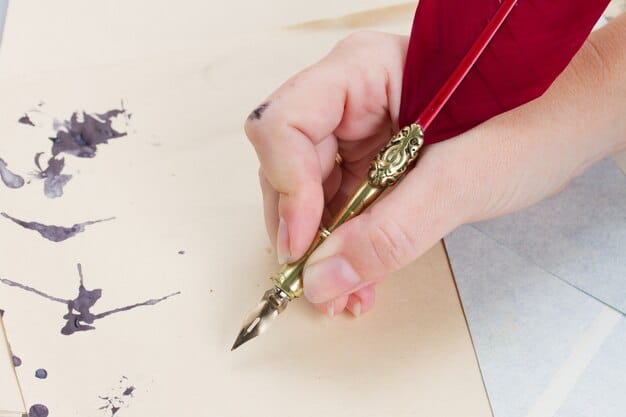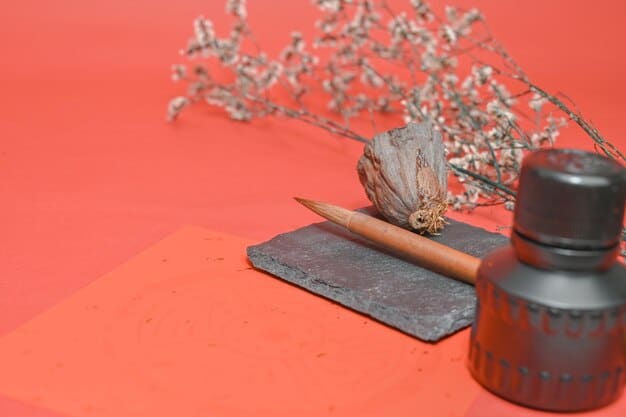Discover Zen Calligraphy: Boost Focus & Mindfulness in 30 Days

Discover the Power of Zen Calligraphy: Improve Focus and Mindfulness in 30 Days by engaging in this ancient art form, learning how deliberate brushstrokes and mindful artistic creation can enhance concentration, reduce stress, and cultivate a deeper sense of inner peace.
Embark on a transformative journey to discover the power of Zen Calligraphy: Improve Focus and Mindfulness in 30 Days. This ancient art offers a unique path to sharpen concentration, reduce stress, and find inner peace through the meditative practice of brushstrokes.
What is Zen Calligraphy? An Introduction
Zen calligraphy, also known as Zenga, is more than just beautiful writing; it’s a practice rooted in Zen Buddhism aiming to express enlightenment and mindfulness through ink and brush. It is a direct expression of the artist’s state of mind, reflecting their understanding of Zen principles.
Unlike traditional calligraphy which focuses on technical skill and aesthetic beauty, Zen calligraphy emphasizes spontaneity and the moment. It’s about letting go of perfectionism and allowing the brush to move freely, guided by intuition and inner peace.
The History of Zen Calligraphy
Zen calligraphy emerged from the Zen Buddhist monasteries of China and Japan. Monks used calligraphy as a form of meditation and a way to convey Zen teachings to others. The practice later became integrated into Japanese culture, influencing various art forms and spiritual practices.
Over time, specific styles and techniques related to Zen calligraphy have evolved, but the core principle remains: to use the act of calligraphy as a form of self-discovery and a vehicle for spiritual expression.
- Edo Period Influence: The Edo period solidified Zen arts within society.
- Modern Day Practice: Today, it’s being rediscovered for its unique blend of art and mindfulness
- Cultural Significance: Deeply connected to traditions highlighting simplicity and purpose.

In conclusion, Zen calligraphy is a unique art form blending artistic expression with Zen principles. It is a powerful way to cultivate mindfulness, improve focus, and gain deeper insights into oneself.
Benefits of Practicing Zen Calligraphy
Practicing Zen calligraphy offers a multitude of benefits that extend beyond artistic expression. It can profoundly impact your mental, emotional, and spiritual well-being. The slow, deliberate strokes provide an opportunity to slow down, quiet the mind, and access inner peace.
By engaging in this mindful art form, you can experience increased focus, reduced stress, and a greater sense of self-awareness. Zen calligraphy is a powerful tool for personal growth and transformation.
Improved Focus and Concentration
Zen calligraphy requires intense focus and concentration. Each stroke demands your full attention, drawing you into the present moment. As you practice, you train your mind to stay present and reduce the impact of distractions.
Over time, this enhanced focus can spill over into other areas of your life, improving your productivity, decision-making, and overall mental clarity.
Stress Reduction and Relaxation
The rhythmic and repetitive nature of Zen calligraphy can be incredibly calming and soothing. As you lose yourself in the flow of creating, stress melts away, and your mind finds a sense of peace. It is a form of active meditation that can lower cortisol levels and promote relaxation.
Furthermore, the focus required helps to gently push aside any worrying or anxious thoughts.
- Reduced Anxiety: Regular sessions are believed to reduce anxiety levels.
- Emotional Release: It enables you to channel emotions into artistic expression.
- Mind-Body Harmony: It integrates mental focus with tactile movement for complete synchronization.
Ultimately, the practice of Zen calligraphy offers a wealth of benefits for both the mind and body. From improved focus and stress reduction to enhanced creativity and spiritual growth, this art form provides a holistic approach to well-being.
Setting Up Your Zen Calligraphy Practice
To begin your Zen calligraphy journey, you’ll need a few essential tools and a dedicated space for practice. Creating a calm and uncluttered environment is crucial for fostering focus and mindfulness.
With the right supplies and mindset, you’re well on your way to experiencing the transformative power of Zen calligraphy.
Essential Tools and Materials
The basic toolkit in Zen calligraphy comprises of the Four Treasures. These includes brush, inkstone, inkstick and absorbent paper. The choice of these tools will directly influence the nature of your created calligraphy.
Experiment with different brushes, inks, and papers to find what works best for you. High-quality materials can significantly enhance your experience and the beauty of your artwork. Using these tools mindfully is part of the practice.
Creating a Dedicated Practice Space
Designate a quiet and distraction-free area in your home for your Zen calligraphy practice. This space should be clean, uncluttered, and conducive to relaxation and concentration. Consider adding elements like plants, candles, or calming music to create a serene atmosphere.
The space becomes like a sanctuary that invites creativity and peace. Ensure everything is within easy reach to maintain flow once practice commences.
- Minimal Distractions: Keep your space free from interruptions.
- Arrange Tools Neatly: Neat arrangements can promote a clear mind.
- Personal Touches: Decorate with calming objects or scenery.

In conclusion, setting up your Zen calligraphy practice involves gathering essential tools and creating a dedicated space that fosters mindfulness and concentration. With the right environment, you can fully immerse yourself in the creative process and unlock the transformative benefits of this ancient art form.
Basic Techniques and Brushstrokes
Mastering the basic techniques and brushstrokes is essential for progressing in Zen calligraphy. Begin by learning the proper way to hold the brush, load it with ink, and create fundamental strokes like horizontal lines, vertical lines, and dots.
Practice these strokes repeatedly until they become natural and fluid. Pay close attention to your posture, breathing, and the pressure you apply to the brush. The goal of Zen calligraphy is to allow your inner energy to guide your brush.
Holding the Brush Correctly
A proper grip can drastically influence control and flow. The brush handle should be vertical and held between thumb, index and middle fingers. The grip should be firm but flexible which maximizes dexterity.
Experiment with different grips to find what works best for you. However, maintain the standard methods, as it is a key component of mastering calligraphy.
Mastering Basic Strokes
The fundamental strokes form the basis of all calligraphy characters. Mastering the straight and curved lines enable one to transition to more complex designs. Start each stroke with focused intention, feeling the ink flow on paper.
Make sure to concentrate on consistency, smooth transitions, and confident execution. With consistent practice, smooth brushwork can be achieved.
In summary, mastering basic techniques and brushstrokes is a foundational step in your Zen calligraphy journey. Through focused instruction and mindful practice, you can unlock the expressiveness of this ancient art form.
Mindfulness Exercises for Calligraphy
Integrating mindfulness exercises into your calligraphy practice can deepen your connection to the present moment and enhance the transformative benefits of this art form. Mindfulness involves paying attention to your thoughts, feelings, and sensations without judgment.
By incorporating mindfulness techniques, you can cultivate a greater sense of self-awareness, reduce stress, and improve concentration during your calligraphy practice. This leads to a more profound and fulfilling experience.
Breathing Techniques
Deep abdominal breathing is invaluable for centering yourself and reducing tension. A few mindful breaths before beginning allows calm and centered brushwork. As you breathe, feel rhythm which encourages a steady hand.
Synchronization is key, allowing harmonious execution. Focus on the flow of breath as it aligns with intention and physical movement to enhance emotional and physical well-being during practice.”
Focusing on the Present Moment
Cultivating presence while working is crucial. Directing full attention to details helps align mind, body, and spirit. Avoid distractions like thoughts and extraneous noises, to sustain a focus and achieve seamless creative flow.
This connection allows for improved focus, intuition and artistic skill.”
- Body Awareness: Notice any stress and adjust posture for better balance.
- Sensory Focus: Concentrate on the feel of brush as it moves on paper.
- Acknowledge Distractions: Gently refocus without scolding yourself
In conclusion, mind exercises are vital in making calligraphy more than just an art; they enable a deeply contemplative practice. Using breath control helps to calm and enhance concentration as creating Zen calligraphy.”
Maintaining Consistency and Overcoming Challenges
Consistency is key to progress. Establish a regular practice routine, even if it’s just for a few minutes each day. The more you practice, the better you’ll become at both the technical aspects of calligraphy and maintaining a mindful state. Regular routines will also reinforce the positive advantages in clarity, concentration, mindfulness.
Furthermore, consistent effort will empower you, boosting determination, confidence, and the spirit in practicing Zen calligraphy, thereby enriching your artistic and meditation abilities.
Establishing a Routine
Creating a steady schedule is key. Commit to specific days and times that encourages mindful routines, rather than sporadic practice. The schedule encourages the activity become a routine and important element of your daily rhythm.
The creation of this consistent practice ensures continuous learning, the fostering of mindfulness to the art. Zen calligraphy is more than a simple artistic effort, it enhances balance between inner state in art.
Dealing with Frustration
Frustration tolerance is crucial particularly whilst mastering new techniques. Instead of allowing irritation stop progress, view errors as chances to learn and build resilience. The act of tolerating frustrations and maintaining a positive approach, will foster patience crucial for personal and creative progress.
Remember the ultimate goal: to advance in a mindful style, that can be achieved only with an acceptance of obstacles on a artistic journey.
- Embrace Imperfection: All creations do not need to be perfect; that are part of process.
- Seek Guidance: Study or request tips from seasoned practitioners to resolve issues.
- Modify Goals: If necessary, adjust ambitions to suit development and keep motivation.
In conclusion, perseverance and a great outlook will enrich journey when engaging with calligraphy. Regularity and stress resistance, will give skills and mindfulness, generating growth.”
| Key Point | Brief Description |
|---|---|
| 🧘 Focus & Mindfulness | Zen calligraphy enhances concentration and reduces stress. |
| 🖌️ Essential Tools | Brush, inkstone, inkstick, and absorbent paper are needed. |
| 🧘 Routine & Patience | Regular practice and patience are vital for progress. |
| 💪Benefits | Lower stress, elevated focus and more creativity. |
FAQ Section
▼
Zen calligraphy is a contemplative art merging calligraphy and Zen concepts to boost alertness and consciousness. Dissimilar to regular methods, it targets spontaneous expression of understanding during actions instead of simply on aesthetics.
▼
To begin, secure the traditional “Four Treasures”: a brush, inkstone, inkstick, and absorbent paper. Selecting high-quality materials can enhance your practice, ensuring better ink flow and overall experience.”
▼
Establish precise times for exercise and ensure that the place you design is peaceful, minimizes disruptions, and offers personal pleasure. Regularity promotes steady progress and embeds reflection in art.
▼
View complications as educational experiences, not setbacks. Use errors to improve, pursue advice from experienced professionals, and remain tolerant. Adjust aims when needed, ensuring dedication persists.”
▼
Integrating deliberate meditation, controlling breath, and targeting present actions enriches connection by the current instant while lowering tension. That focus translates to improved clearness, strength, plus the depth inside artwork.”
Conclusion
Embarking on a 30-day journey to discover the power of Zen Calligraphy: Improve Focus and Mindfulness in 30 Days offers a pathway to enhanced concentration, reduced stress, and a deeper sense of inner peace. By embracing this ancient art form, you can unlock your creative potential while cultivating a more mindful and balanced life. Start today and experience the transformative power of Zen calligraphy.





